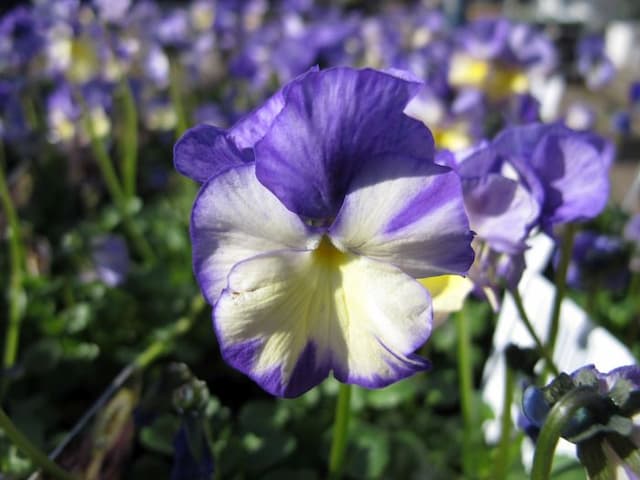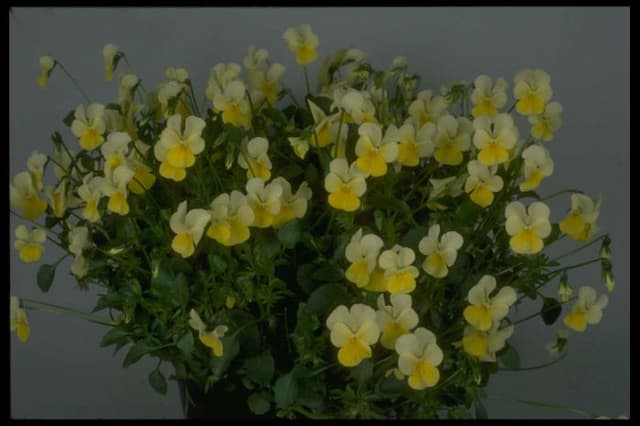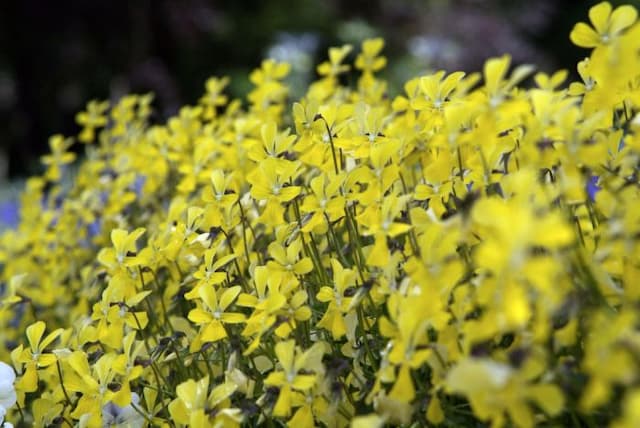Pansy Viola × wittrockiana Joker Series (P)

ABOUT
Viola × wittrockiana Joker Series, commonly known as the pansy, is a hybrid plant known for its vibrant and colorful flowers. These flowers are the most distinct feature of the plant, typically showcasing a face-like pattern with a unique blending of hues. The petals can exhibit a wide array of colors, including purples, yellows, blues, and even bold blacks. The petals of the pansy are often rounded with slight ruffling at the edges, creating a delicate, velvet-like appearance. The center of the flower usually has a deep, darker color that radiates outwards to lighter shades, providing a bold contrast that accentuates the face-like design. This characteristic blotching at the center is commonly referred to as the "blotch" or "face." The foliage of the plant is equally lush, with green, heart-shaped leaves that are slightly scalloped and have a gentle texture. The leaves and the flowers together make the pansy a favorite among gardeners and flower enthusiasts alike for adding a splash of color to gardens and floral arrangements.
About this plant
 Names
NamesFamily
Violaceae
Synonyms
Pansy, Garden Pansy, Joker Pansy
Common names
Viola x wittrockiana Joker Series.
 Toxicity
ToxicityTo humans
Pansy is not commonly known for being toxic to humans. If ingested in large amounts, it could possibly cause mild gastrointestinal upset, but it is generally considered to be safe.
To pets
Pansy is generally considered to be non-toxic to pets. If a pet ingests a large amount of the plant, it might experience mild gastrointestinal upset, but it is not known for being poisonous to cats, dogs, or other pets.
 Characteristics
CharacteristicsLife cycle
Biennials
Foliage type
Deciduous
Color of leaves
Green
Flower color
Mixed
Height
6-10 inches (15-25 cm)
Spread
6-10 inches (15-25 cm)
Plant type
Herb
Hardiness zones
7
Native area
Hybrid
Benefits
 General Benefits
General Benefits- Aesthetic Appeal: Adds vibrant color and visual interest to gardens and landscapes.
- Variety of Colors: Comes in a wide range of colors, allowing for creative garden designs.
- Extended Blooming: Often has a long flowering period, providing color throughout the growing season.
- Easy to Grow: Generally easy to care for, which makes them suitable for novice gardeners.
- Attracts Pollinators: Flowers can attract butterflies and bees, supporting local ecosystems.
- Versatility: Suitable for beds, borders, containers, and hanging baskets, offering diverse landscaping options.
- Cold Tolerance: Can withstand cooler temperatures, making them a good choice for early spring and fall planting.
- Edible Flowers: Flowers are edible and can be used as garnishes or in salads for culinary purposes.
 Medical Properties
Medical PropertiesThis plant is not used for medical purposes.
 Air-purifying Qualities
Air-purifying QualitiesThis plant is not specifically known for air purifying qualities.
 Other Uses
Other Uses- The pansy petals can be used to add a splash of color to salads and desserts, providing a decorative edible garnish that's also mildly flavored.
- Pansy flowers can be pressed and included in paper making for unique stationery, adding a floral touch to handwritten letters and cards.
- Dried pansy petals are sometimes used in potpourri mixes to lend their color and a subtle fragrance to the mix.
- During the Victorian era, pansy bouquets were used to convey secret messages, with each color symbolizing a different emotion or sentiment.
- Pansies can be candied and used as edible decorations on cakes, cupcakes, and other pastries, combining both visual appeal and taste.
- Pansy flowers are used in the art of flower pounding, where the petals transfer their color to fabric or paper for a natural artistic effect.
- The vibrant flowers can be incorporated into ice cubes, imparting an aesthetic flair to cold beverages and cocktails.
- Pansies are often used in DIY natural dyes for fabrics, yarns, and handmade papers, offering a range of colors from yellow and blue to purple.
- Artists sometimes use pansy flowers as subjects for botanical illustrations, capturing their vivid colors and unique patterns in detail.
- Frozen pansy flowers can be included in homemade popsicles, imparting a whimsical, garden-themed appearance to the treats.
Interesting Facts
 Feng Shui
Feng ShuiThe Pansy is not used in Feng Shui practice.
 Zodiac Sign Compitability
Zodiac Sign CompitabilityThe Pansy is not used in astrology practice.
 Plant Symbolism
Plant Symbolism- Love: The pansy is often associated with the idea of love, whether it's romantic, platonic, or familial. Because of their bright and varied colors, they are thought to represent affection and to be given as a token of love.
- Free-thinking: The word "pansy" comes from the French word "pensée," which means "thought" or "remembrance." Due to this etymology, pansies have become symbols of free thought and contemplation.
- Remembrance: Pansies have also been used to signify loving memories or to honor someone who has passed away, making them common in funerary bouquets and memorials.
- Reflection: Because of their "face-like" appearance, pansies are seen to represent introspection and the human soul, inviting us to look within ourselves.
- Compassion: Given their gentle appearance, pansies are often associated with empathy and the consideration of others' feelings.
 Water
WaterPansies should be watered when the top inch of the soil feels dry to the touch. It's best to water them thoroughly, ensuring moisture reaches the roots, about once a week, but this can vary depending on climate and soil drainage. During hot, dry periods, watering may be needed more frequently, possibly every few days. Use about a half to one gallon of water per square yard of soil each time you water, always checking moisture levels beforehand to avoid overwatering. In winter, reduce the amount of water provided to prevent root rot in cooler temperatures.
 Light
LightPansies thrive in full to partial sunlight. The ideal spot for them is where they can receive at least 6 hours of daylight. However, in warmer climates, they benefit from afternoon shade to protect them against the heat of the day. Avoid placing them in deep shade, as this can inhibit their growth and flowering.
 Temperature
TemperaturePansies prefer cool temperatures and will flourish in a range that is between 40°F and 60°F. They can survive brief periods as low as 20°F and as high as 80°F but perform best within their ideal range. Pansies are often planted in the fall or early spring when temperatures are within their preferred comfort zone.
 Pruning
PruningPansies benefit from deadheading, which means removing faded or dead flowers to encourage more blooms. Prune out spent flowers and any damaged or diseased foliage whenever necessary throughout the growing season. The best time for pruning is in the late evening or on an overcast day to avoid stressing the plant.
 Cleaning
CleaningAs needed
 Soil
SoilPansies thrive in moist, well-draining soil with a pH range of 6.0 to 6.5. A good soil mix for pansies includes equal parts of loam, peat moss, and perlite or coarse sand to ensure proper drainage and aeration.
 Repotting
RepottingPansies typically do not require frequent repotting. Replant or refresh the soil in their containers once every year or two to ensure they have enough nutrients and space to grow.
 Humidity & Misting
Humidity & MistingPansies prefer average humidity levels but are adaptable to various conditions. They grow well outdoors with natural humidity and do not require specific humidity adjustments.
 Suitable locations
Suitable locationsIndoor
Place pansies near bright window, avoid excess heat for indoor growth.
Outdoor
Full to partial sun, shelter from extreme heat, enrich garden soil.
Hardiness zone
6-10 USDA
 Life cycle
Life cyclePansy (Viola × wittrockiana Joker Series) starts its life cycle as a seed, often planted in early spring or fall when temperatures are cool. After germination, the seedling emerges and establishes itself, growing into a vegetative state with characteristic heart-shaped leaves. As the plant matures, it begins to develop flowers that come in a wide range of colors, often with distinctive 'faces,' which can occur in early spring or fall depending on the planting time. These flowers are capable of both self-pollination and cross-pollination through insect activity, leading to the production of seeds within the three-valved capsules. Once the seeds have matured, they are dispersed by various means, including wind, water, or by adhering to animals and people. After dispersing, the seeds may lie dormant until conditions are favorable again for germination, thus completing the lifecycle and beginning a new generation.
 Propogation
PropogationPropogation time
Spring to Summer
The most popular method of propagating Pansies, Viola × wittrockiana Joker Series, is through seed sowing. Pansy seeds are best sown indoors approximately 14 to 16 weeks before the last frost date. The seeds require darkness for germination, so they should be covered lightly with soil. The ideal temperature for germination is around 65 to 75 degrees Fahrenheit (18 to 24 degrees Celsius). Seedlings typically emerge in 1 to 2 weeks. Once they're large enough to handle, the seedlings can be transplanted into individual pots or cells and gradually acclimated to outdoor conditions before being planted into the garden after the danger of frost has passed.









